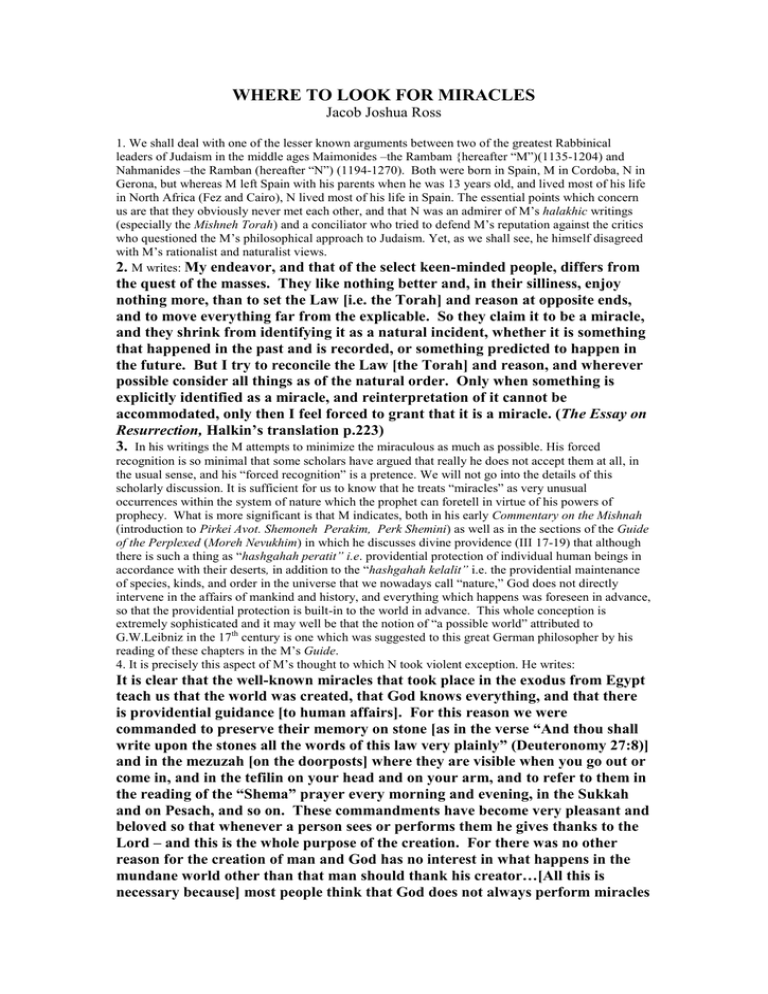WHERE TO LOOK FOR MIRACLES Jacob Joshua Ross
advertisement

WHERE TO LOOK FOR MIRACLES
Jacob Joshua Ross
1. We shall deal with one of the lesser known arguments between two of the greatest Rabbinical
leaders of Judaism in the middle ages Maimonides –the Rambam {hereafter “M”)(1135-1204) and
Nahmanides –the Ramban (hereafter “N”) (1194-1270). Both were born in Spain, M in Cordoba, N in
Gerona, but whereas M left Spain with his parents when he was 13 years old, and lived most of his life
in North Africa (Fez and Cairo), N lived most of his life in Spain. The essential points which concern
us are that they obviously never met each other, and that N was an admirer of M’s halakhic writings
(especially the Mishneh Torah) and a conciliator who tried to defend M’s reputation against the critics
who questioned the M’s philosophical approach to Judaism. Yet, as we shall see, he himself disagreed
with M’s rationalist and naturalist views.
2. M writes: My endeavor, and that of the select keen-minded people, differs from
the quest of the masses. They like nothing better and, in their silliness, enjoy
nothing more, than to set the Law [i.e. the Torah] and reason at opposite ends,
and to move everything far from the explicable. So they claim it to be a miracle,
and they shrink from identifying it as a natural incident, whether it is something
that happened in the past and is recorded, or something predicted to happen in
the future. But I try to reconcile the Law [the Torah] and reason, and wherever
possible consider all things as of the natural order. Only when something is
explicitly identified as a miracle, and reinterpretation of it cannot be
accommodated, only then I feel forced to grant that it is a miracle. (The Essay on
Resurrection, Halkin’s translation p.223)
3. In his writings the M attempts to minimize the miraculous as much as possible. His forced
recognition is so minimal that some scholars have argued that really he does not accept them at all, in
the usual sense, and his “forced recognition” is a pretence. We will not go into the details of this
scholarly discussion. It is sufficient for us to know that he treats “miracles” as very unusual
occurrences within the system of nature which the prophet can foretell in virtue of his powers of
prophecy. What is more significant is that M indicates, both in his early Commentary on the Mishnah
(introduction to Pirkei Avot. Shemoneh Perakim, Perk Shemini) as well as in the sections of the Guide
of the Perplexed (Moreh Nevukhim) in which he discusses divine providence (III 17-19) that although
there is such a thing as “hashgahah peratit” i.e. providential protection of individual human beings in
accordance with their deserts, in addition to the “hashgahah kelalit” i.e. the providential maintenance
of species, kinds, and order in the universe that we nowadays call “nature,” God does not directly
intervene in the affairs of mankind and history, and everything which happens was foreseen in advance,
so that the providential protection is built-in to the world in advance. This whole conception is
extremely sophisticated and it may well be that the notion of “a possible world” attributed to
G.W.Leibniz in the 17th century is one which was suggested to this great German philosopher by his
reading of these chapters in the M’s Guide.
4. It is precisely this aspect of M’s thought to which N took violent exception. He writes:
It is clear that the well-known miracles that took place in the exodus from Egypt
teach us that the world was created, that God knows everything, and that there
is providential guidance [to human affairs]. For this reason we were
commanded to preserve their memory on stone [as in the verse “And thou shall
write upon the stones all the words of this law very plainly” (Deuteronomy 27:8)]
and in the mezuzah [on the doorposts] where they are visible when you go out or
come in, and in the tefilin on your head and on your arm, and to refer to them in
the reading of the “Shema” prayer every morning and evening, in the Sukkah
and on Pesach, and so on. These commandments have become very pleasant and
beloved so that whenever a person sees or performs them he gives thanks to the
Lord – and this is the whole purpose of the creation. For there was no other
reason for the creation of man and God has no interest in what happens in the
mundane world other than that man should thank his creator…[All this is
necessary because] most people think that God does not always perform miracles
and that the world simply carries on [naturally] in its normal fashion. This is
what many of the philosophers suppose and the Rav [i.e. the Rambam] is one of
them. However when we look more closely we can see that no person has a
portion in the Torah of Moses our teacher until he recognizes that all our affairs
and actions are bound up with miracles. Our success in their performance is not
natural or part of the habitual custom of the world. For all the rewards [and
punishments] of the Torah are complete miracles. (N’s Sermon: The Torah of
God is Perfect, my translation of Chavell’s edition pp. 152-3)
4. This sermon was delivered in the synagogue in Barcelona and contains many excerpts from the N’s
commentary on the Torah. Much of the above quotation is to be found also in N’s commentary on
Exodus 13:8 and there he says more explicitly of such miracles in Israel’s past that …these great
miracles and signs of the past are trustworthy evidence for belief in the Creator
and the Torah in general. Since the Almighty will not perform such miracles and
signs in every generation for any transgressor or unbeliever, He commanded us
[=our forefathers] to practice mitzvot which recall what our[=their] eyes saw and
pass these on to their children, and children’s children until the last generation.
He laid down grave punishments for the failure to perform these mitzvot …and
from the memory of these great and famous miracles a person comes recognize
the hidden miracles which are the foundation of the whole Torah for no person
has a portion in the Torah of Moses our teacher until he recognizes that all our
affairs and incidents are bound up with miracles and are not natural or part of
normal course of events, whether these concern individuals or communities.
5. (1) N regards the great miracles of the past as pedagogical intimations to us of these hidden miracles
which we must learn to recognize. Hidden miracles are those which occur within the normal function
of natural events. It is the intervention of the divine that is hidden ,and we must learn to seek in them
“the hand of God” (2) There is a tradition from Shmuel Hanagid,and Avraham Ibn Ezra based on
Talmudic sources that one’s fate may be changed by “jumping over” stellar influence as the result of
“cleaving” directly to God. N too believes that events may also be fated by the stars (astrology) (3)
Prayer, both communal and personal, is a means of “cleaving” to God, and so too is the meticulous
observance of God’s commandments (4) Hence an occurrence (such as the recovery of a beloved
person from a serious disease) may be accidental or fated, but if it occurs as the answer to our prayers
we may well regard it as a hidden miracle. (5)N seemingly qualifies this by saying that: You should
know that miracles, whether for the good or the bad, are performed only for the
completely righteous or the completely wicked. But those in the middle range
may expect good or bad to be done to them within the normal way of the world,
that is, only in accordance with their own way of life and deeds. (commentary to
Deuteronomy 11:13) But the context of the remark seems to indicate that he is speaking of the
providential care given to individuals in a group the majority of which are righteous or wicked.
6. There are similarities between M and N: for example “hashgahah peratit”(M) = “nes nistar”(N).
But also big differences which explain why M could never have accepted the idea of “nes nistar” :
(1) For M there is no divine intervention after the creation of the universe, since this would be a
change of the divine creative Will (“ratson kadum”) which means that it was less than perfect, whereas
for N continuous divine intervention is the very essence of the relationship between God and the
universe (2)For M there is only one form of relationship between God and the world which is fixed,
designed, and natural and the greatness and wisdom of the Creator is evidenced in the enormous
complexity of the design in the universe. Man has to learn to fit in with design, understand it and
achieve immortality and the Love of God. The measure of s person’s hashgahah peratit (the
providental care which he may expect to enjoy) is the extent of his intellectual perfection.; For N there
are two forms of relationship between God and the world, the first something wrongly called “nature”
but which is really a fixed miracle “nes kavua” with regard to generalities, species and sorts, and the
second a hidden miracle “nes nistar” which shows itself in the divine interventions with regard to the
particular events concerning individuals or groups which would otherwise be accidental or fated by the
stars.








